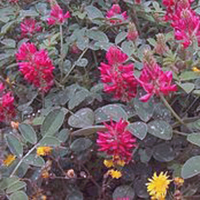The overseeding of two cool-season legumes (Hedysarum coronarium L. and Trifolium incarnatum L.) on switchgrass (Panicum virgatum L.) mature stands increased biomass productivity
DOI:
https://doi.org/10.4081/ija.2020.1510Keywords:
Sustainable intensification, Mediterranean environment, Blackwell, Alamo, relay intercropping.Abstract
In the Mediterranean rainfed systems, perennial warm-season grasses are profitable crops for the production of herbage as forage or feedstock for bioenergy purposes. During summer, when the production of cool-season crops is scarce, warm-season grasses can improve the productivity and stability of forage cropping systems. In Italy, switchgrass (Panicum virgatum L.) can be cultivated for herbage production or as energy crop. The objective of this work was evaluating if relay intercropping with cool-season legumes could be suited to convert a mature stand of switchgrass from energy to dual, energy and forage, production, together with improving the productivity and the quality of the harvestable biomass. All these things considered, a field experiment was carried out in Central Italy, on mature stands of two switchgrass varieties, Alamo and Blackwell, overseeded with two legumes: sulla (Hedysarum coronarium L.) and crimson clover (Trifolium incarnatum L.). The intercropping system was compared with fertilized and un-fertilized pure switchgrass stands. After two years of study, data showed that the intercropping increased the total above ground biomass (AGB) productivity. In the second year, the increase in total AGB production for switchgrass mixtures compared with the pure stands was greater for sulla, a biennial legume, than crimson clover.
Downloads

Published
How to Cite
Issue
Section
License
PAGEPress has chosen to apply the Creative Commons Attribution NonCommercial 4.0 International License (CC BY-NC 4.0) to all manuscripts to be published.
